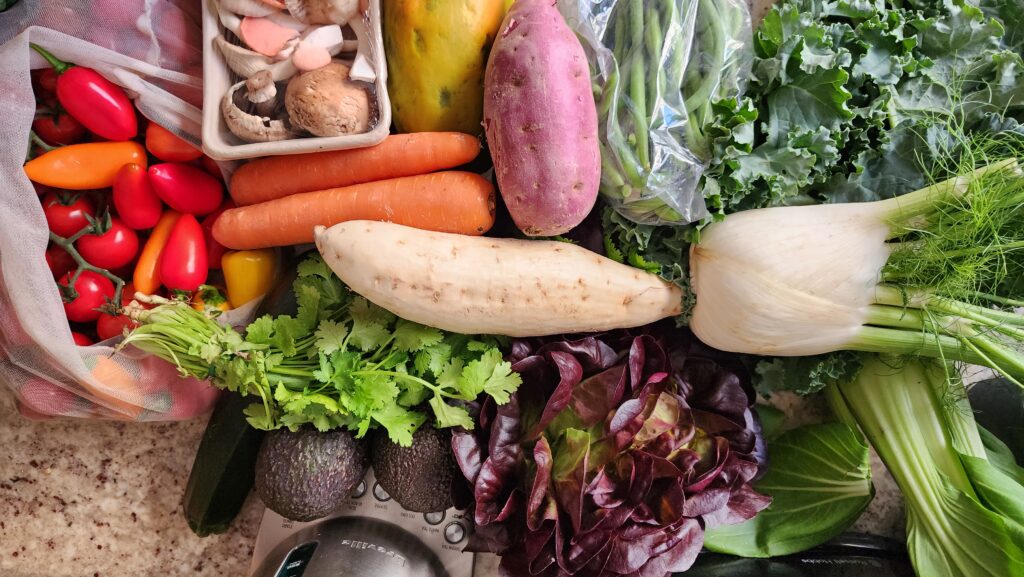People would normally say eating healthy is expensive. But doctor’s visits can be costly too. Managing food costs while maintaining a nutritious, healthy diet can seem challenging, but with the right strategies in place, it’s easily achievable. Let’s dive deeper into how you can stretch your grocery dollars further while enjoying delicious, healthy meals.
1. Plan Your Meals
Take meal planning to the next level by considering not only dinners but also breakfasts, lunches, and snacks. Look for recipes that use overlapping ingredients to minimize waste and maximize usage. For example, if you buy spinach, plan a salad for one meal, add some to a smoothie, and incorporate the remainder into a pasta dish later in the week. Stop buying ready-made meals instead, invest in an afternoon batch cooking your ready-made meals for the freezer.
2. Shop with a List
A detailed shopping list acts as your map in the grocery store, guiding you away from unnecessary purchases. Organize your list by store sections (produce, dairy, meats, dry goods) to streamline your shopping trip and reduce the temptation to wander through aisles with non-essential items.

3. Loyalty Programs
Beyond casual deal usage, actively seek out deals through store newsletters, websites, and apps. Some stores offer personalized discounts based on your shopping history, so signing up for loyalty programs can lead to significant savings over time.
4. Choose Store Brands
Experiment with store brands, which are often produced in the same facilities as name brands. Start with staple items like baking ingredients, spices, and canned goods—many shoppers find there’s little to no difference in quality. Compare the nutritional panels to confirm the cheaper option is the best. More affordable options can be higher in sodium or additives.
5. Shop in Bulk
Bulk bins can be a goldmine for savings, especially for items like grains, nuts, and spices. You can buy exactly the amount you need, which is particularly cost-effective for expensive items like nuts or for trying new ingredients without committing to a large package.
6. Shop Seasonally and Locally
Understand the seasonal cycles of produce to make cost-effective purchases. For example, buying strawberries in winter can be costly compared to their summer prices. Buy strawberries in bulk during summer and freeze them when you need them. Local farmers’ markets often offer competitive prices on organic and local produce, which also supports the local economy. I buy most of my food at our local markets

7. Avoid Shopping When Hungry
The old advice of not shopping while hungry is so true. Studies have shown that hungry shoppers are more likely to buy high-calorie, less healthy foods. Eating a healthy snack before shopping can help you stick to your list and avoid impulsive choices driven by hunger. Talk about impulsive shopping it can cost you an arm and a leg over time.
8. Compare Prices
Many grocery stores now offer price comparison tools on their mobile apps, allowing you to check if what you’re buying is the best deal available. Take a few seconds to do a quick check while you shop, especially for more expensive items. To maximize your savings, take the time to compare prices for products available in various forms and from different sources. Evaluate the prices of fresh versus frozen seafood to see which offers better value. Check the cost differences between fresh, canned, and frozen corn. Also, consider comparing the prices of bulk nuts that you scoop yourself to those of prepackaged options.
9. DIY
While pre-sliced or pre-cooked items save time, they’re often more expensive. Invest time on a weekend to do meal prep, slicing vegetables, or cooking staples like rice or beans in bulk. This approach offers the convenience of ready-to-use ingredients without the added cost. Preparing everything from scratch is cheaper, and you’ll know exactly what’s gone into each dish.
10. Mix up your protein
Meat is often the most expensive item in the grocery basket. Incorporating plant-based proteins like lentils, chickpeas, and tofu can reduce your grocery bill and add variety to your diet. These proteins are not only cheaper but also healthy and can be used in a wide range of recipes from different cuisines.
Takeaway
Smart grocery shopping is about more than just chasing deals—it’s about making strategic decisions that align with your dietary needs and budget constraints. By adopting these detailed strategies, you can enjoy nutritious meals without overspending, ensuring that both your belly and wallet remain full.





